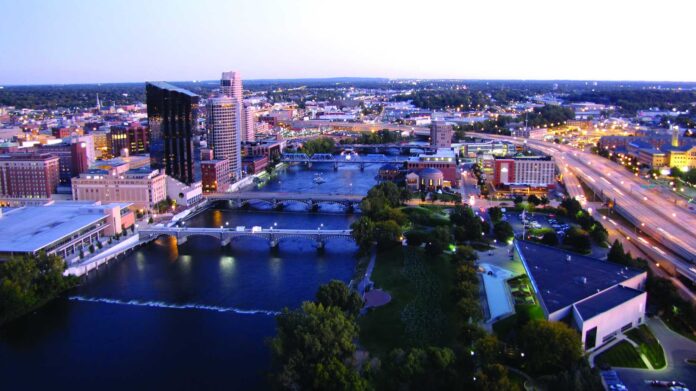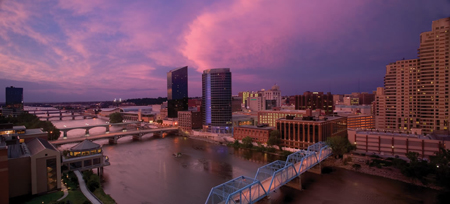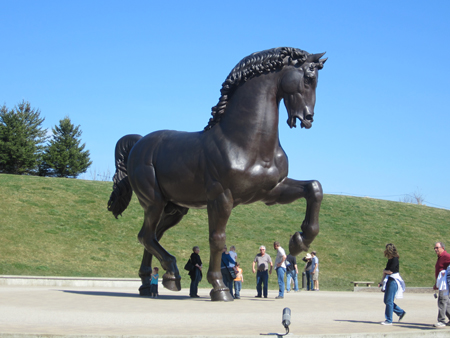
Grand Rapids, Mich., has built a downtown with many of the same puzzle pieces we have in Downtown Toledo. It is on a river and close to one of the Great Lakes; it has an arena for concerts and hockey and a convention center; it has a world-class museum and a thriving arts scene; it has a children’s museum and a library; it has offices for a daily newspaper and city government; it has restaurants, an Irish pub and an Ottawa Tavern that calls itself the “OT.”
But while Toledo continues to leave many of its puzzle pieces in the box, Grand Rapids has taken advantage of geography and cooperation to build a true destination city and has pioneered an art event that in 2011 drew 325,000 people who spent $10 million in 19 days. There are lessons to be learned from Grand Rapids, but be warned: Some of those lessons contain hard truths that reveal a limit to the Glass City’s aspirations.
Apples to apples
Grand Rapids, 185 miles northwest of Toledo, is Michigan’s second-largest city — 192,000 people live within its borders; 600,000 live in its Kent County area. The Experience Grand Rapids website describes the city as “a remarkable combination of urban sophistication and small town warmth, known for its philanthropic and sustainable driven community.”
Sound familiar?
I have lived and worked in Toledo for 40 of my 45 years. I visited Grand Rapids from March 15-18, for about 45 hours. I recognize that the emotional thrill of infatuation with a new city and the adventure of travel demands the balance of intellectual perspective. I have no doubt that Grand Rapids has its problems and challenges, and that more time there would reveal some of those issues. But I noticed two themes that merit discussion and study for people invested in Toledo. Discussing these topics does not mean Grand Rapids is better than Toledo or that Toledo should aspire to be Grand Rapids (any more than it should aspire to be Columbus, Ann Arbor or Chicago), but when such a clear model for improvement presents itself, it is better to look it in the eye and face it than to bury one’s head in the sand and ignore the potential.
Proximity
The first advantage I observed in Grand Rapids can never be duplicated in Toledo. So why discuss it? Because understanding parameters and limitations is an important part of character and comprehension of reality. I opened this discussion by listing many of the things Grand Rapids and Toledo share in their downtown areas. The key difference is proximity. Every Grand Rapids attraction listed at the beginning of this commentary — the arena, convention center, museum(s), children’s museum, library, scores of restaurants, even that Irish pub — are within a one-mile radius, along with a major hospital and college. Even the John Ball Zoo is less than two miles from downtown Grand Rapids. For reference, it’s just under two miles from Imagination Station to the Toledo Museum of Art. It is four miles from Imagination Station to the Toledo Zoo. It is five miles from Imagination Station to the University of Toledo.
The Grand Rapids airport (Gerald R. Ford International, which is Michigan’s second-busiest airport) is 14 miles from downtown. Toledo Express is 16 miles from Imagination Station, unless you flew in to Detroit, in which case you must travel 50 miles to see Downtown Toledo.
Even the Frederik Meijer Gardens and Sculpture Park, which cannot be adequately described in this limited space, is only five miles from downtown. Elmore’s Schedel Arboretum and Gardens is 18 miles from Downtown, not exactly a long drive, but in Toledo-think, that’s “a hike.”
Toledo’s highlights can compete with any city’s, but they are scattered in a sprawling manner that prevents any sense of true destination and community, in terms of tourism and marketable identity. That lack of proximity is an immutable fact; Lloyd Jacobs is not going to move University Hall to the Berdan Building and Randy Oostra is not going to relocate a ProMedica hospital to the old Owens Corning building. But proximity is not Grand Rapids’ only advantage.
Attitudes and extras
My wife and I stayed at the Amway Grand Plaza Hotel, 24 floors above the Grand River. The service and aesthetic quality of the Amway are a reminder of one of developer Bruce Rumpf’s themes: Downtown Toledo lacks a hotel that can stand with the nation’s finest. The Amway valet captain asked if it was our first visit to Grand Rapids. We affirmed that it was, and he said, unabashedly, “Welcome to Grand Rapids. Make our downtown your playground.” That might look corny on the printed page, but he said the words with pride and warmth.
I wonder if any of the staff at Toledo’s hotels are welcoming guests with such a mixture of chamber-of-commerce gushing and true hometown pride.
That welcome set the tone for the weekend (a celebration of our 10th wedding anniversary), at restaurants, shops and with people we met on our travels. The Experience Grand Rapids Convention and Visitors Bureau arranged our hotel stay and one interview with ArtPrize organizers, but at no point in the weekend did I reveal my media identity and we paid for our own admissions and excursions; the “secret shopper” approach is the only honest way to evaluate an experience and avoid invoking Heisenberg’s Uncertainty Principle.
In addition to a walking-distance experience, Grand Rapids offers a nicety I observed in Washington, D.C., and Chicago: parks and greenspace. Our Metropark system is a marvel, but the Lorax would die if his life depended on living in the few trees our downtown harbors. Grand Rapids also makes the most of its riverfront with parks, boardwalks and building entrances up and down the downtown watersides.
Toledo is investing in Promenade Park; if it can generate a fraction of the waterfront activity Grand Rapids enjoys, it will be a worthy investment.
ArtPrize
The other great lesson from Grand Rapids is dangling like a ripe piece of low-hanging fruit: cooperation, embodied by the city’s ArtPrize event.
Far from the city, as one travels the highways leading to Grand Rapids, there are billboards that read, “Cool City, Hot Art,” followed by billboards for specific galleries and exhibits. The city works on branding itself as an art destination well before its borders. It would be like seeing billboards for Toledo Museum of Art exhibits and Toledo Symphony Orchestra events while driving in from Fort Wayne or Chicago or Cleveland or Columbus.
While in Grand Rapids, I met with ArtPrize Executive Director and COO Catherine Creamer and Public Relations Director Brian Burch.
ArtPrize was founded in 2009 as an open art competition. According to an economic impact study, the 2011 event (in just its third year) hosted 1,582 artists at 164 venues, competing for nearly $500,000 in cash prizes, determined by public vote. In its 19-day span, more than 325,000 attended the event, spending $10 million during their stay. It’s like the Arts Commission’s Art Walk series on steroids, with a major cash prize at the end.
“We have a unique ecosystem of partners,” Burch said. “The arts organizations, which traditionally competed with each other for funding, saw a need to do what was best for Grand Rapids. City leaders cooperated and ArtPrize came together in an unprecedented collaboration.”
Best of all, ArtPrize’s $2 million operating budget comes from sponsors, donations, event fees and sales, not from taxpayers. And of that $2 million, $1.9 million is spent in Grand Rapids on local goods and services.
Creamer said the public-voting element is also key to ArtPrize’s success: “The public vote is a function of engagement that, during ArtPrize, makes art impossible to ignore.”
Toledo arts organizations spend a tremendous amount of energy fighting for funds and territory, which results in the greatest of those institutions being stuck in old-model relationships, refusing to open their futures to newer ways of doing business. It’s ironic, but while I always hear that Toledo artists do not like to compete with each other, that’s standard operating procedure for the big-time Toledo arts institutions.
ArtPrize is not a blueprint that could be lifted whole and dropped in Toledo, but the concept is adaptable and with planning and cooperation could be a model for an event that would represent a seismic shift in Toledo’s tourism efforts.
Call for action
It would be beneficial for a Toledo delegation to visit Grand Rapids for the September ArtPrize. Toledo Free Press will take responsibility for arranging a night’s stay and a visit with ArtPrize officials, then for hosting a follow-up meeting to discuss the potential of emulating the event here. There should be an official from city government, someone from the Arts Commission, probably representatives from the Toledo Museum of Art, Toledo Symphony Orchestra, Tahree Lane from The Blade and a wild card or two.
I would love to see such a trip happen, but I am not going to hold my breath waiting. Cooperation is a far more flexible concept than proximity, but for Toledo arts organizations, it seems it is also a concept with as little hope for change.
Michael S. Miller is editor in chief of Toledo Free Press and Toledo Free Press Star. Email him at mmiller@toledofreepress.com.
























